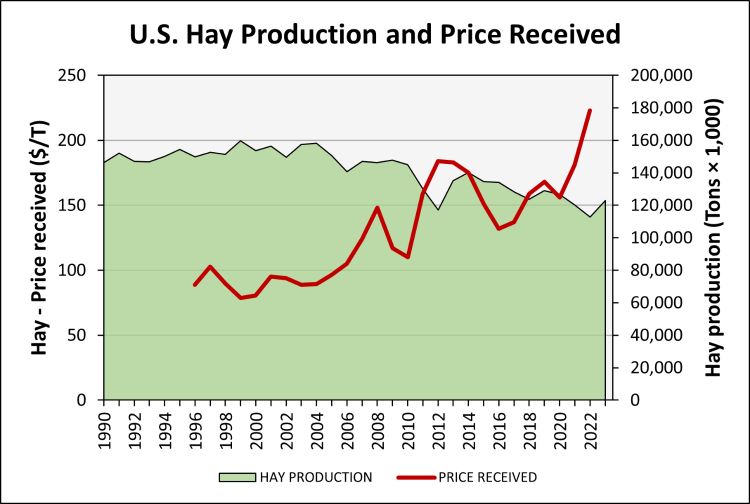Source: Michigan State University Extension, Jerad Jaborek
Limit-feeding corn grain can be economically advantageous when the price of hay becomes too high due to short supply.

During the winter when pastures are no longer a viable feed option, hay becomes the most common feedstuff fed to beef cows. Additionally, during drought conditions, pasture no longer exists as a viable feed option and cattle producers resort to feeding hay. Unfortunately, drought conditions can also make it very difficult to grow and harvest enough hay needed to feed the cow herd when pasture is unavailable.
U.S. hay production has declined the past couple years due to widespread drought across much of the country (Figure 1.). Decreased hay production has created a greater demand for hay and as a result the price of hay has increased. What other feed options do you have besides hay?
A viable option to replace ad libitum (i.e., free-choice) hay may be to limit-feed or restrict-feed corn to your beef cows. For three straight winters, this option was tested by Steven Loerch with The Ohio State University beef cow herd until the cow herd finished calving. Diets were formulated to meet the nutritional requirements of 1,300 lb. gestating beef cows. For limit-fed corn diets, cows were transitioned to the high-concentrate diet over the course of four days and received 1.7-2.6 lb. of hay per head per day, depending on the trial year, to maintain proper rumen health. Whole shelled corn was fed at 9.9 lb. per head per day and was increased when temperatures decreased and energy demands were greater for the cow. A pelleted supplement was also fed to the limit-fed corn group to supply adequate protein via soybean meal and urea, and supply calcium, vitamins, and Monensin. The quality of orchard grass hay round bales offered to the ad libitum hay group consisted of 9-10% crude protein and 68-75% neutral detergent fiber (NDF). Hay waste was assumed to be 10%, which is within the range commonly reported for feeding round bales in feeders.
Offering hay and supplying Monensin in the supplement, prevented cows from experiencing digestive upsets while being fed a high-concentrate diet. Feeding whole shelled corn also slows down the rate of diet fermentation in comparison with feeding processed (i.e., cracked, rolled, ground, steam-flaked) corn. Not surprisingly, cows that were limit-fed corn expressed behavioral signs of being hungry and boredom. Offering extra hay may be a potential solution, but results in a greater feed cost.
Overall, cows limit-fed corn consumed 52-58% less feed on a dry matter basis and at a 40-49% reduced feed cost. Corn has more than twice the energy content and supplies a greater amount of energy per dollar compared with hay. Thus, resulting in a reduced feed intake and feed cost to supply similar amounts of energy. Monensin supplementation likely helped to reduce feed intake and feed costs as well. In two subsequent trials with beef heifers, Monensin supplementation was shown to reduce feed intake by 7.5% compared with no Monensin supplementation.
In these experiments, corn cost $2/bushel ($71/ton), hay cost $80/ton, and the supplement cost $150/ton. With current market prices, assuming costs for corn = $4.75/bushel ($169/ton), hay = $200/ton, supplement = ~$450/ton, Table 1 illustrates how limit-feeding corn is still a cheaper option today than providing beef cows with free-choice hay.
Table 1. Cost comparison of limit-feeding corn versus free-choice hay offered to beef cows
| Feed Ingredient | Limit-fed corn | Free-choice hay |
| Hay | 2.2 lb. × $0.10/lb. = $0.22 | 29.5 lb. × $0.10/lb. = $2.95 |
| Corn | 12.5 lb. × $0.085/lb. = $1.06 | – |
| Supplement | 2.2 lb. × $0.225/lb. = $0.50 | – |
| Total | $1.78/d | $2.95/d |
The limit-feeding strategy resulted in greater variation in body weight change compared with cows offered free-choice hay, but differences were not consistent between the two different groups. Part of this can be explained by the changing energy demands caused by the fluctuating temperatures during the cold winters, hence why corn supplementation had to be increased at certain times during each of the three trials. Meanwhile, cows offered free-choice hay were able to consume more hay until they achieved gut fill, and then energy intake became limited as well.
On average, cows that were limit-fed corn produced calves that were heavier at birth compared with cows offered free-choice hay, with no reported difference in calving difficulty. Calves from cows limit-fed corn typically yielded heavier weaning weights as well. Conception rates were similar across treatments. If the amount of body weight lost during winter is too great, it can negatively affect conception rates the following year, as was demonstrated in the third trial. Generally, early- and mid-gestation is the time to add body weight and condition back to cows after the calves have been weaned. During late-gestation and early lactation cows will be mobilizing energy toward the fetus and for milk production needed to feed their calf and not towards their own body weight gain.
The idea of restricted feeding came from previous work by Loerch with backgrounding systems for growing cattle before they were transitioned to a feedlot diet. This restricted-feeding concept has also been applied to feedlot cattle during the finishing phase as well.









